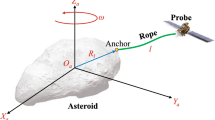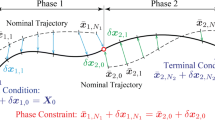Abstract
A new era of up-close asteroid exploration has been entered in the 21st century. However, the widely rugged terrain and microgravity field of asteroids still pose significant challenges to the stable landing of spacecraft and may even directly lead to the escape of the explorer. Owing to the substantial energy dissipation arising from the interaction among multiple bodies, the flexible net, which is a typical multibody system, may be capable of overcoming the above problems. In this study, a dynamical model was established to analyze the movement of the flexible net spacecraft (FNS) near and on the asteroid comprehensively. First, we investigated the dynamical environment of the target asteroid by combining the polyhedron method and spherical harmonics parametric surface modeling approach. Thereafter, we constructed the multibody dynamics model of the explorer using the linear Kelvin–Voigt method. Subsequently, we studied the collision process between the FNS and asteroid based on the spring–damper contact dynamics model. The trajectory and speed of the FNS could be derived by solving the system dynamic equations in parallel. Finally, we analyzed the deformation, descent, jumping motion, and surface movement process of the FNS during the movement. Consequently, a promising scheme is provided for asteroid exploration missions in the future.

Similar content being viewed by others
Change history
11 February 2022
A Correction to this paper has been published: https://doi.org/10.1007/s42064-022-0136-2
References
Bottke, W. F., Cellino, A., Paolicchi, P., Binzel, R. P. Asteroids III. Tucson: Univ. Arizona Press, 2001: 3–15.
Castillo-Rogez, J. C., Pavone, M., Nesnas, I. A. D., Hoffman, J. A. Expected science return of spatially-extended in-situ exploration at small solar system bodies. In: Proceedings of the IEEE Aerospace Conference, 2012: 1–15.
Anthony, N., Emami, M. R. Asteroid engineering: The state-of-the-art of Near-Earth Asteroids science and technology. Progress in Aerospace Sciences, 2018, 100(6): 1–17.
Feng, J., Hou, X., Armellin, R. Survey on studies about model uncertainties in small body explorations. Progress in Aerospace Sciences, 2019, 110(10): 1–12.
Normile, D. Asteroid mission faces ‘breathtaking’ touchdown. Science, 2019, 363(6422): 16–17.
Yoshimitsu, T., Kubota, T., Nakatani, I. M. INERVA rover which became a small artificial solar satellite. In: Proceedings of the 20th Annual AIAA/USU Conference on Small Satellites, 2006: SSC06-IV-4
Michel, P., O’Brien, D. P., Abe, S., Hirata, N. Itokawa’s cratering record as observed by Hayabusa: Implications for its age and collisional history. Icarus, 2009, 200(2): 503–513.
Lowry, S. C., Weissman, P. R., Hicks, M. D., Whiteley, R. J., Larson, S. Physical properties of Asteroid (25143) Itokawa—Target of the Hayabusa sample return mission. Icarus, 2005, 176(2): 408–417.
Abe, S., Mukai, T., Hirata, N., Barnouin-Jha, O. S., Cheng, A. F., Demura, H., Gaskell, R. W., Hashimoto, T., Hiraoka, K., Honda, T. et al. Mass and local topography measurements of Itokawa by Hayabusa. Science, 2006, 312(5778): 1344–1347.
Lederer S. M., Domingue, D. L., Vilas, F., Abe, M., Farnham, T. L., Jarvis, K. S., Lowry, S. C., Ohba, Y., Weissman, P. R., French, L. M. Physical characteristics of Hayabusa target Asteroid 25143 Itokawa. Icarus, 2005, 173(1): 153–165.
Kawaguchi, J., Fujiwara, A., Uesugi, T. Hayabusa—Its technology and science accomplishment summary and hayabusa-2. Acta Astronautica, 2008, 62(10–11): 639–647.
Fujiwara, A., Kawaguchi, J., Yeomans, D. K., Abe, M., Mukai, T., Saito, J., Yano, H., Yoshikawa, M., Scheeres, D. J., Barmouin-Jha, O. et al. The rubble-pile asteroid Itokawa as observed by Hayabusa. Science, 2006, 312(5778): 1330–1344.
Taylor, M. G. G. T., Altobelli, N., Buratti, B. J., Choukroun, M. The Rosetta mission orbiter science overview: The comet phase. Philosophical Transactions, 2017, 375(2097): 20160262.
Ulamec, S., Biele, J., Blazquez, A., Cozzoni, B., Delmas, C., Fantinati, C., Gaudon, P., Geurts, K., Jurado, E., Kuchemann, O. et al. Rosetta Lande—Philae: Landing preparations. Acta Astronautica, 2015, 107: 79–86.
Jurado, E., Martin, T., Canalias, E., Blazquez, A., Garmier, R., Ceolin, T., Gaudon, P., Delmas, C., Biele, J., Ulamec, S. et al. Rosetta lander Philae: Flight dynamics analyses for landing site selection and post-landing operations. Acta Astronautica, 2016, 125: 65–79.
Baranyai, T., Várkonyi, P. L., Balázs, A. Rotational motion of the spacecraft Philae during landing on comet 67P/churyumov-gerasimenko. Journal of Spacecraft and Rockets, 2017, 54(3): 554–565.
Schroder S. E., Mottola, S., Arnold, G., Grothues, H.-G., Jaumann, R., Keller, H. U., Michaelis, H., Bibring, J.-P., Pelivan, I., Koncz, A. et al. Close-up images of the final Philae landing site on comet 67P/Churyumov-Gerasimenko acquired by the ROLIS camera. Icarus, 2017, 285: 263–274.
Watanabe, S., Hirabayashi, M., Hirata, N., Noguchi, R., Shimaki, Y., Ikeda, H., Tatsumi, E., Yoshikawa, M., Kikuchi, S., Yabuta, H. et al. Hayabusa2 arrives at the carbonaceous asteroid 162173 Ryugu—A spinning top-shaped rubble pile. Science, 2019, 364(6437): 268–272.
Ogawa, N., Terui, F., Mimasu, Y., Yoshikawa, K., Ono, G., Yasuda, S., Matsushima, K., Masuda, T., Hihara, H., Sano, J. et al. Image-based autonomous navigation of Hayabusa2 using artificial landmarks: The design and brief in-flight results of the first landing on asteroid Ryugu. Astrodynamics, 2020, 4(2): 89–103.
Tsuda, Y., Takeuchi, H., Ogawa, N., Ono, G., Kikuchi, S., Oki, Y., Ishiguro, M., Kuroda, D., Urakawa, S., Okumura, S. I. et al. Rendezvous to asteroid with highly uncertain ephemeris: Hayabusa2’s Ryugu-approach operation result. Astrodynamics, 2020, 4(2): 137–147.
Morota, T., Sugita, S., Cho, Y., Kanamaru, M., Tatsumi, E., Sakatani, N., Honda, R., Hirata, N., Kikuchi, H., Yamada, M. et al. Sample collection from asteroid (162173) Ryugu by Hayabusa2: Implications for surface evolution. Science, 2020, 368(6491): 654–659.
Sugita, S., Honda, R., Morota, T., Kameda, S., Sawada, H., Tatsumi, E., Yamada, M., Honda, C., Yokota, Y., Kouyama, T. et al. The geomorphology, color, and thermal properties of Ryugu: Implications for parent-body processes. Science, 2019, 364(6437): 252.
Takao, Y., Mimasu, Y., Tsuda, Y. Simultaneous estimation of spacecraft position and asteroid diameter during final approach of Hayabusa2 to Ryugu. Astrodynamics, 2020, 4(2): 163–175.
Yoshikawa, K., Sawada, H., Kikuchi, S., Ogawa, N., Mimasu, Y., Ono, G., Takei, Y., Terui, F., Saiki, T., Yasuda, S., et al. Modeling and analysis of Hayabusa2 touchdown. Astrodynamics, 2020, 4(2): 119–135.
Arakawa, M., Saiki, T., Wada, K., Ogawa, K., Kadono, T., Shirai, K., Sawada, H., Ishibashi, K., Honda, R., Sakatani, N. et al. An artificial impact on the asteroid (162173) Ryugu formed a crater in the gravity-dominated regime. Science, 2020, 368(6486): 67–71.
Scheeres, D. J., McMahon, J. W., French, A. S., Brack, D. N., Chesley, S. R., Farnocchia, D., Takahashi, Y., Leonard, J. M., Geeraert, J., Page, B. et al. The dynamic geophysical environment of (101955) Bennu based on OSIRIS-REx measurements. Nature Astronomy, 2019, 3(4): 352–361.
Hamilton, V. E., Simon, A. A., Christensen, P. R., Reuter, B. E., Clark, M. A., Barucci, N. E., Bowles, W. V., Boynton, J. R., Cloutis, E. A. Connolly, K. L. Jr. et al. Evidence for widespread hydrated minerals on asteroid (101955) Bennu. Nature Astronomy, 2019, 3(4): 332–340.
Hergenrother, C. W., Maleszewski, C. K., Nolan, M. C., Li, J.-Y., Droue d’Aubigny, C. Y., Shelly, F. C., Howell, E. S., Kareta, T. R., Izawa, M. R. M., Barucci, M. A. et al. The operational environment and rotational acceleration of asteroid (101955) Bennu from OSIRIS-REx observations. Nature Communications, 2019, 10(1): 1291.
Dellagiustina, D. N., Emery, J. P., Golish, D. R., Rozitis, B., Bennett, C. A., Bueke, K. N., Ballouz, R.-L., Becker, K. J., Christensen, P. R. Drouet d’Aubigny, C. Y. et al. Properties of rubble-pile asteroid (101955) Bennu from OSIRIS-REx imaging and thermal analysis. Nature Astronomy, 2019, 3(4): 341–351.
Lauretta, D. S., Bartels, A. E., Barucci, M. A., Bierhaus, E. B., Binzel, R. P., Bottke, W. F., Campins, H., Chesley, S. R., Clark, B. C., Clark, B. E. et al. The OSIRIS-REx target asteroid (101955) Bennu: Constraints on its physical, geological, and dynamical nature from astronomical observations. Meteoritics & Planetary Science, 2014, 50(4): 834–849.
Lauretta, D. S., Dellagiustina, D. N., Bennett, C. A., Golish, D. R., Becker, K. J., Balram-Knutson, S. S., Barnouin, O. S., Becker, T. L., Bottke, W. F., Boynton, W. V. et al. The unexpected surface of asteroid (101955) Bennu. Nature, 2019, 568(7750): 55–60.
Lauretta, D. S., Hergenrother, C. W., Chesley, S. R., Leonard, J. M., Pelgrift, J. Y., Adam, C. D., Al Asad, M., Antreasian, P. G., Ballouz, R. L., Becker, K. J. et al. Episodes of particle ejection from the surface of the active asteroid (101955) Bennu. Science, 2019, 366(6470): eaay3544.
Shan, M., Guo, J., Gill, E. Contact dynamic models of space debris capturing using a net. Acta Astronautica, 2019, 158: 198–205.
Zhao, Y., Huang, P., Zhang, F., Meng, Z. Contact dynamics and control for tethered space net robot. IEEE Transactions on Aerospace and Electronic Systems, 2019, 55(2): 918–929.
Liu, Y., Huang, P., Zhang, F., Zhao, Y. Robust distributed consensus for deployment of Tethered Space Net Robot. Aerospace Science and Technology, 2018, 77: 524–533.
Scheeres, D. J. Orbital mechanics about small bodies. Acta Astronautica, 2012, 72: 1–14.
Hamilton, D. P., Burns, J. A. Orbital stability zones about asteroids: II. The destabilizing effects of eccentric orbits and of solar radiation. Icarus, 1991, 96: 43–64.
Werner, R. A. The gravitational potential of a homogeneous polyhedron or don’t cut corners. Celestial Mechanics and Dynamical Astronomy, 1994, 59(3): 253–278.
Yu, Y., Michel, P., Hirabayashi, M., Schwartz, S. R., Zhang, Y., Richardson, D. C., Liu, X. The dynamical complexity of surface mass shedding from a top-shaped asteroid near the critical spin limit. Astronomical Journal, 2018, 156(2): 59.
Botta, E. M., Sharf, I., Misra, A. K., Teichmann, M. On the simulation of tether-nets for space debris capture with Vortex Dynamics. Acta Astronautica, 2016, 123: 91–102.
Acknowledgements
This work was supported by the National Key R&D Program of China (No. 2019YFA0706500).
Author information
Authors and Affiliations
Corresponding author
Additional information
Yu Zhang received his B.S. degree in engineering from the South China University of Technology, China, in 2020. At present, he is a graduate student at Tsinghua University. His current research interest is nonlinear dynamics theory.
Yang Yu is currently an associate professor at Beihang University in Beijing, China. He joined the Faculty of Theoretical Mechanics in April 2016. He obtained his B.S. degree in physics from Beihang University in 2009 and his Ph.D. degree in aeronautics & astronautics from Tsinghua University in 2014. He held a postdoctoral position at Observatoire de la Côte d’Azur in France from 2014 to 2016. His research interests include the Hamiltonian dynamics of celestial systems, and the formation and evolution of solar system small bodies.
Hexi Baoyin is currently a professor at Tsinghua University. His current research interests include orbit theory in irregular gravitational fields, and interplanetary mission analysis and optimization.
Rights and permissions
About this article
Cite this article
Zhang, Y., Yu, Y. & Baoyin, H. Dynamical behavior of flexible net spacecraft for landing on asteroid. Astrodyn 5, 249–261 (2021). https://doi.org/10.1007/s42064-021-0102-4
Received:
Accepted:
Published:
Issue Date:
DOI: https://doi.org/10.1007/s42064-021-0102-4




